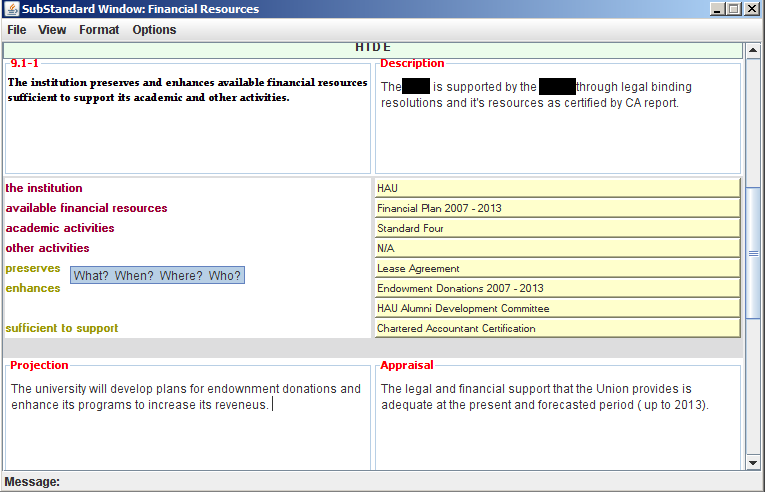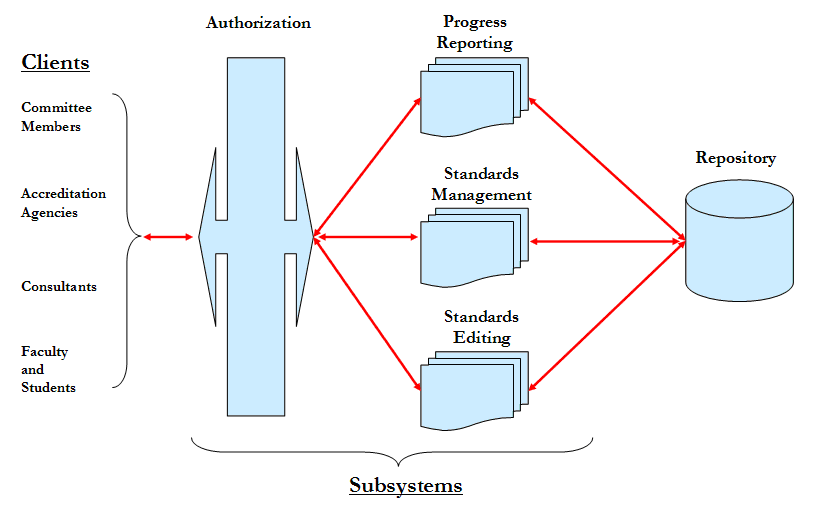Accreditation Management System - AMS
Description
The purpose of this research is to develop a knowledge management tool that addresses the needs of the higher education institutions in terms of their self evaluation process. The tool bridges the gap between the collection, handling and distribution of data by engaging the various stakeholders in a dialogue and action to improve outcomes. It was initially modelled along the quality assurance standards and processes of NEASC but it can now be customised to any accreditation/quality assurance process.
The general environment that universities operate can be depicted as:

In response to the current self assessment needs the development and implementation of an automated tool that will assist and guide accreditation processed was justified. AMS aims at addressing both the technology culture and the information culture of an institution. Both cultures are unique to the organizational context of existing universities. Our technology culture is about the use and integration of technology in planning, development, operations, and assessment while the information culture involves information policies and practices for sharing information within and across the organization (like ownership of information)
It was evident from the analysis that a process-based application was required that would promote a collaborative approach to assessment, encouraging broad participation in the assessment process and ensuring reflective analysis of the assessment results. The traditional framework for action in approaching the organization and management of the self study follows certain general principles and procedures. The AMS is organized around a steering committee concept that is composed of a chairperson, chairs responsible for each standard, members, and guests who also play the role of advisors. The chairperson s role is planning and overseeing of the work produced by the rest of the team, suggest approaches and assume the responsibility for having the final report edited. He also reviews the standards for accreditation set by the corresponding quality assurance agency and makes sure that all the ways in which the institution provides its academic program to students are incorporated into the self study.The chairs of each standard are responsible for organizing the efforts needed to address the requirements of their corresponding standards by assigning duties to members of the team. They report directly to the committee chair. The different roles don t necessary assigned to separate single individuals. For example the committee chair can also be the chair of some standards and a certain standard might have more than one chair. Committee members work to ensure inquisitiveness and reflection and are responsible for gathering information, evidence and data.
The analysis is organized around the analytical framework of description, appraisal and projection as suggested by NEASC. This organized triad help group all the possible questions that can be expressed through the six interrogatives of the English language What, When, Who, Where, How and Why. The first five are primarily addressing the statements made by the institution and dominate the description and projection sections while the Why is primarily the focus of the appraisal section. The triad is organized in a clock wise cyclical fashion in the application window to represent the flow of time from past, present, and future.

More analytically the framework has as follows:
Description: The present status of the university is presented with respect to the adopted standards. A balance is required between providing too much or too little. The various areas of operations need to be presented in a concise way and references or links to existing publications can be included. This section will provide the appropriate groundwork for understanding the concerns raised in the ensuing appraisal and projection sections. In essence, this section sets the stage and provides the context for meaningful analysis of the institution in terms of the various standards.
Appraisal/Evaluation/Assessment: This is the section were the analysis takes place. The institution is required to make a thorough assessment of the effectiveness of its practices in a given area, recognizing both the institution s achievements and its problems. In this section the institution will summarize its self evaluation as to how well it meets the standard and provide links to sufficient evidence so that the reader of the report understands the basis on which the judgements were made.
Projection/Planning: After the appraisal section the institutions are expected to indicate plans developed to maintain and enhance strengths and address areas of concern. Emphasis on realistic and specific projections should be given that represent a definite commitment to development in the areas addressed by the standards in the near future. It is in this section that the results of the self-evaluation are translated into practice.
Given the cyclic nature of the three sections that sort of follow the time continuum of Past, Present and Future the process is expected to offer a complete coverage of the self assessment process. The Description section can be seen as a reference to the Past albeit a very close one, the Present can be expressed through the appraisal section since it represents our current awareness of the situation and the future is represented with the Projection section where future planning and actions are described. The framework can be repeated at any level in depth until it reaches the literal atomic units that are the words of the text (figure bellow). Between the framework triad (Description, Appraisal, and Projection) we can see the final breakdown in the literal atomic elements of the text. These are organized in two different categories in order to further assist the user s inquisitiveness and offer a complete coverage of every conceivable element of the academic standard.The first category of literal atomic elements represents the nouns in the text sentence while the second category represents the verbs of the sentence. Tool tip messages have been implemented to remind the user that nouns help him address questions of What, When, Where, and Who, while verbs (and adverbs) help him provide explanations and rationales through Why and How questions.


At a higher level the work is organized like:

and at the final level that is accessible by the accreditation agenies takes the form of a regular document with link/hyperlink capabilities:

Overall the AMS application was broken down into the following subsystems and modules - an authorization subsystem, a progress reporting subsystem, a standard s editing subsystem, a standard s management subsystem, a repository of information (DBMS) module, a server management module and a collaboration/communication module. The difference between the module and subsystem classification is that subsystems can be considered as independent entities that are doing all the intelligence of the application while the modules are functional entities used by many subsystems.

Publications/Presentations
Harkiolakis N., A Knowledge Management Approach to the Accreditation Process of Higher Education Institutions", Paris International Conference of Education, Economy & Society, Paris, France, July 17 19, 2008
Harkiolakis, N., Koutoulas, G., An Automated Approach to Quality Assurance in Higher Education Institutions - The User Perspective , 2nd Athens International Conference on University Assessment - Assessing Quality, Athens, Greece, October 12-14, 2007.
Harkiolakis N., An automated approach to assessment management in higher education institutions , 11th WSEAS International Conference on Computers, Ag. Nikolaos, Greece, July 26-28, 2007.